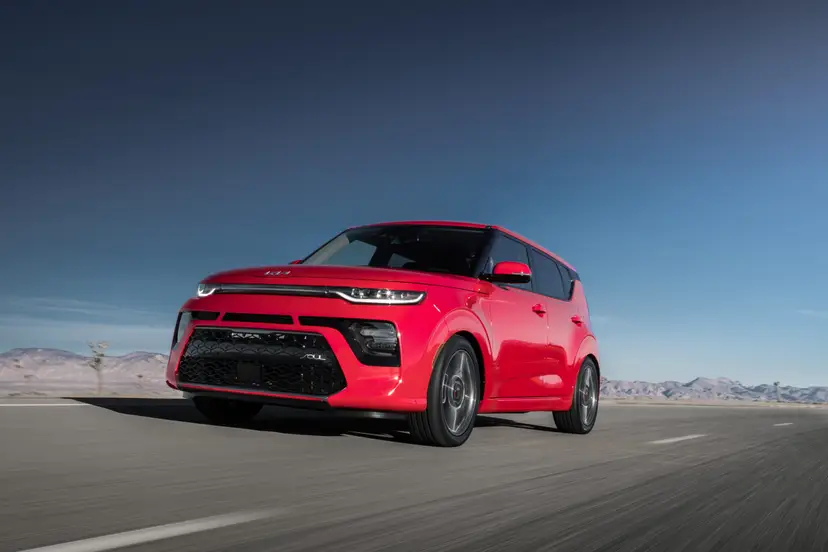
Editor’s note: This review was written in October 2013 about the 2014 Kia Soul. Little of substance has changed with this year’s model. To see what’s new for 2015, click here, or check out a side-by-side comparison of the two model years.
As of the 2013 model year, the first-generation Kia Soul was more than 4 years old, and in today’s fast-moving world of vehicle design, that’s quite old (an adjective Kia certainly wouldn’t want associated with its brand). It was time for a complete makeover.
Kia delivers with an all-new Soul for 2014, an ever-so-slightly more mature version that still manages to keep its youthful Soul soul.
Just about everything on the 2014 Soul is new — save for the general funky vibe. (Compare the 2013 and 2014 versions side by side here.) The once-trendy segment of square breadboxes on wheels appears to be waning, though the Scion xB and Nissan Cube continue for yet another model year despite continued rumors of their impending demise. Today’s Soul competitors might also include the shapelier Fiat 500L and Mini Countryman. Compare them with the Soul here.
The 2014 Soul comes in three trims. The base features a 1.6-liter four-cylinder engine with either a six-speed manual or automatic transmission. The Plus and top-of-the-line Exclaim come with a more powerful 2.0-liter and only with the automatic. I drove both the Plus and the Exclaim. See them all side by side here.
Exterior & Styling
Kia uses its clever and wildly popular hamster ad campaign to demonstrate the transformation of both the new Soul and the hamsters. The newly refined hamsters have lost quite a bit of weight and have a sleek, modern, hipster boy-band appeal, as does the new Soul.
While the Soul retains its iconic square shape with angular side rear windows, the sharp corners have been smoothed out just a tad, as have most of the lines throughout the car. That bit of cheap-looking black plastic that used to run along the side is no longer there distracting the eye.
“Striking the right balance between the original car with its audacious proportion and stance was daunting,” according to Tom Kearny, Kia’s chief U.S. designer. The resulting look and feel are exactly what Kia was after: a design that’s slightly more refined and upscale without losing any of its edge.
The new Soul is just a smidge larger in almost every direction but up. Its wheelbase has stretched 0.8 inch and its width increased by 0.6 inch. The Soul’s overall height decreased by 0.4 inch.
How It Drives
I had the benefit of recently driving the 2013 Soul at home with my backseat test riders scrutinizing every last detail. Check out that review here. While I certainly appreciated the cute, funky fun of this stylish budget-mobile, I was ready to be done with it after a week. The harsh suspension in the previous-generation Soul made the car skip around on me when taking on bumps or rough pavement at speed, and a high level of cabin noise induced some annoyance and fatigue during longer trips.
There has been drastic improvement in both of these areas in the 2014 Soul. A revised front and rear suspension design takes the edge off of a previously harsh ride, and now the Soul feels more like a real car rather than a toy. While it’s nowhere near soft and floaty, rough pavement is no longer jarring, and larger bumps in the road are absorbed better and recovered from quickly.
An additional focus on noise damping inside the new Soul was aided by slight improvements to the car’s aerodynamics as well as baked expansion foam sealing (envision that cool purple foam that you see sprayed into a house’s walls on HGTV makeover shows) and a reinforced isolation pad in the floor. These measures in combination have worked. The 2014 Soul was quiet enough inside to carry on a pleasant conversation for the entirety of the six hours I spent as both driver and passenger.
Soul owners tend to use their vehicles for around-town trips, and Kia has improved the feel to be zippier off the line and give just enough of that fun feeling to keep you entertained. While the acceleration fun-factor is a bonus, what goes up must come down, and that includes speed: Initially, the Soul’s brakes feel a bit touchy and over-responsive, but after a few blocks of stop-and-go city driving, I managed to lighten up my touch enough to smooth out the braking.
While my drive route through the generally flat farmlands outside of Minneapolis didn’t give me any twisty roads to experience true cornering, the Soul does feature a standard Flex Steer system on all trim levels. This allows the driver to toggle between Sport, Normal and Comfort modes. I tried them out, but my drive route didn’t allow enough diversity to notice any difference between them.
The Soul Plus’ and Exclaim’s beefier 164-horsepower, 2.0-liter four-cylinder engine with automatic transmission gets an EPA-estimated 23/31 mpg city/highway, a slight bump up from last year’s 23/28 mpg. The base 130-hp 1.6-liter engine gets an EPA-estimated 24/30 mpg, compared with last year’s 25/30 mpg.
In comparison, the 500L’s automatic transmission gets 25/33/27 mpg city/highway/combined, while the Countryman gets a similar 25/30/27 mpg. The xB gets 22/28/24 mpg.
Interior
Kia has been upping the ante of its products over the past few years, offering add-on features that aren’t available even as extras in their competitors’ cars. This makes Kia’s vehicles customizable for an upscale feeling. If features like a heated steering wheel, heated front and rear outboard seats and ventilated front seats get you as excited as they do me, it might be time to look into a Kia.
The new Soul’s entire interior has been upgraded from the previous generation’s kitschy, trendy fabrics and cheap-looking hard-plastic surfaces. The 2014 has a softer and more upscale feel with higher-quality texture and finishes. The steering wheel is now covered in hand-stitched leather, which Kia claims is akin to a solid handshake because it’s the one part of the vehicle that the driver is in constant direct contact with. I agree; there’s nothing worse than a limp handshake or flimsy-feeling steering wheel.
An optional panoramic moonroof opens up the feel of the Soul’s backseat, treating rear passengers to a great sky view. With the exception of the moonroof, backseat passengers weren’t really a driving force in the Soul’s redesign. A Kia engineer told me it’s considered more of a “me-centric” car, referring to the driver.
The Soul’s increased footprint mostly benefits the front seats, with an additional 0.8 inch of legroom. Headroom up front has also been increased by 0.2 inch, and front shoulder room has been bumped up 0.3 inch. A little bit of love for the backseat passengers was thrown in with an extra 0.2 inch in legroom.
There are small bottleholders in each of the back doors, a small storage pocket on the back of the passenger’s seat (but not the driver’s seat) and two cupholders in the backseat’s fold-down center armrest. The Soul definitely wasn’t designed as a family hauler, but the backseat’s perfectly flat floor means families that do have to haul kids or teenagers around from time to time can do so with ease of movement for both people and their stuff.
Ergonomics & Electronics
The 2014 Soul features an optional new Android-based connected car operating system called UVO that combines familiar mechanical buttons and dials with an 8-inch capacitive touch-screen. A split-screen option allows the driver to keep an eye on the navigation system while simultaneously displaying the audio screen, requiring less toggling between screens and theoretically less driver distraction.
The average Soul buyer is about 48 years old, according to Kia. Downsizing boomers will be attracted to the simple button and dial operations. Despite the age of the buyer, the majority of Soul drivers (the kids of the buyers) are expected to be quite young. The younger generation will appreciate the UVO connected car features such as integrated Pandora internet radio operated through the vehicle’s touch-screen and audio controls, so there’s no need to fumble with a smartphone.
The UVO-connected Soul arrives with a three-month complimentary SiriusXM Data subscription that gives the driver “access to travel information such as road conditions, weather and security alerts as well as sports scores, movie times, stock prices and fuel prices,” according to Kia.
Cargo & Storage
The cargo opening in the new Soul has widened by 2.4 inches, leaving little to no surrounding lip to have to maneuver around when loading stuff.
The exterior growth has also led to nearly 2 additional cubic feet of storage. To give you an idea of what that looks like, about 7.5 gallons of water could fit in 1 cubic foot of space, so 2 cubic feet makes for a lot of extra ballet shoes for my family of three dancing daughters.
Even though the measured difference is only 1.1 cubic feet, the Soul’s 24.2 cubic feet of total cargo space behind the backseat feels quite large compared with the Fiat 500L’s 23.1 cubic feet, and massive compared with the Countryman’s puny 16.5 cubic feet and the xB’s minuscule 11.6 cubic feet.
Safety
Crash tests have not yet been conducted on the 2014 Soul.
Latch child-safety-seat anchors in the new Soul are housed within open depressions in the seat bight. While I didn’t have the opportunity to install car seats in the 2014 Soul, my experience suggests it should be seamless. Children in booster seats, however, might get slightly frustrated with the Soul’s backseat seat belt buckles, which are secured with flimsy nylon straps (rather than held upright on stiff bases). These can be more difficult for children with limited dexterity to buckle up.
See all the standard safety features listed here.
Value In Its Class
With an entry price of just $14,700, the Soul is in the perfect position to be the most affordable choice for young hipsters wanting form, functionality, safety and individuality in the car they choose to drive them through their diverse, evolving lives. Add to that the ability to customize the Soul’s features from plain Jane to mighty Max and the car can appeal to a broad range of buyers regardless of age or income level.










































